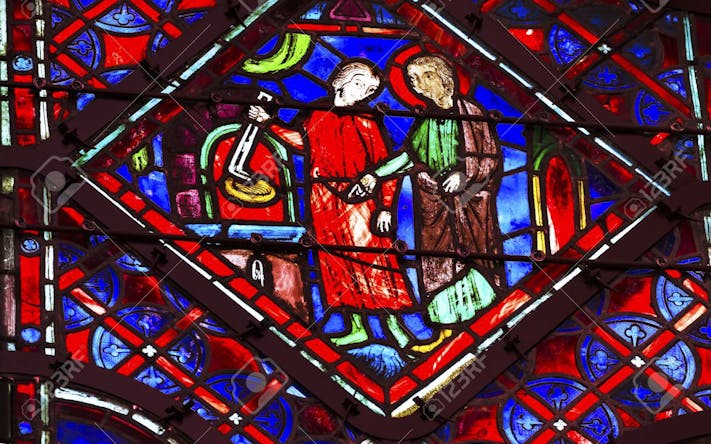At a time when many choirs marked the 300th anniversary of the first performance of Bach’s St John Passion in St Thomas’ Church, Leipzig, it was important not to ignore the other of his great Passions that have come down to us.
On Easter Saturday John Lubbock and his carefully assembled forces gave a powerful account of the St Matthew, more complex in its structure and composed on a much larger scale than the earlier work. This was successfully conceived not so much as a concert but rather as an act of worship, a musical religious experience, so much so, in fact, that the Abbey’s rector emphasised (“on pain of death”) the conductor’s request that there should be no applause before, during or after the performance. We complied.
This monumental work was probably first performed on Good Friday 1727, led by the Cantor of St Thomas’, J S Bach himself. Scored for two orchestras, two choirs and soloists, it is likely that Bach’s musical forces on that occasion were not dissimilar from those in this performance, for which the space available would have been a similar constraint. Despite this, the balance and clarity achieved throughout were notable, and indeed, the closeness of the performers to each other and to the congregation/audience enhanced both the drama of the narrative, especially in the compelling choruses, and the intimacy of the soloists’ reflections in the arias.
The account of the events of the Passion is told by the Evangelist, who links together Matthew’s Biblical text, the additional poetic commentaries and the chorales. Robert Jenkins was outstanding in the role, making both musical and narrative sense of the demanding recitatives, sensitively supported throughout by the excellent continuo ensemble. His vocal range appeared effortless and his dramatic communication magnetic, whether at the hushed moments when Jesus “held His peace”, “yielded up the Ghost” or immediately afterwards when “the earth did tremble”. George Robarts brought a commanding intensity to his portrayal of Jesus. Beneath the canopy of warm string sound, he conveyed the uncanny confidence with which Jesus predicts the unfolding events with quiet dignity and a deceptively simple timbre. The honesty of his singing, the directness of his diction and his loving arioso call to his disciples over the bread and wine were notable features. So, visually, was his withering silence in response to Pilate, sung by Frazer Scott who, alone among the other soloists, represented one specific character. Scott’s venomous reference to Barabbas contrasted strongly with his silky tone at the name of Jesus, and his self-serving innocence was consistently persuasive.
The quartet of soloists commented beautifully on the action with sadness, love or despair, although it was a shame to be denied the musical completeness of the da capo repeats. David Pike’s dramatic engagement with Jesus was particularly effective in Peter’s three denials, but he also brought a rich tone and sensitivity to his arias, especially “Come healing cross” and the lilting, final “World, depart, let Jesus in!”. Xavier Hetherington sang with passion and an almost operatic fervour which, at times, was overwhelming in its vehemence, when a more restrained interpretation might have served the poetry more sensitively. His piano singing, for example in the opening of “Endure”, was beautifully eloquent (and grippingly accompanied by Sarah Small’s scourging viola da gamba).
The alto soloist is the first to appear, and Charlotte Tetley set the mood for the drama about to unfold. Hers was a mesmerising portrayal of grief, her tone dignified, her aural imagery – whether of a serpent or of sighing and weeping – immediate and deeply affecting. In her soprano role Hannah Davey soared to celestial heights with phrasing and a purity of tone that added a further spiritual element to the performance. Her sense of unity with the instrumental accompaniments enhanced each of her arias, and tears were not far away in “For love my Saviour now is dying”.
The chorus is a major actor in the drama, and the OSJ Voices rose well to the multiple and varied challenges. Their chorales were rich in tone and deliberate in tempo, and tellingly intimate when, in “Be near me, Lord, when dying”, some of the choir simply hummed. The opening chorus was perhaps too stately, but the dramatic crowd scenes pulsated with accusatory energy and urgency, although occasionally not every section could match the power and clarity of the sopranos. The slower, quieter choral singing was evocative and very sensitive (“Truly this was the Son of God” was a fine example). The Girls’ Choir brought an added glister to the great opening chorale.
The Orchestra of St John’s proved the bedrock of both the drama and the reflective pauses in it, whether creating an aural thunderstorm or conveying the restlessness of “O man, lament”, or, as soloists, producing the most heartrending obbligato accompaniments to arias. The wind instruments excelled in their sustained phrasing and rich tone, the solo violins too in the achingly beautiful “Have mercy, Lord” or the breathless virtuoso role in “Give me back my Saviour”. The continuo remained unfailingly supportive and responsive.
So magisterial was John Lubbock’s direction, yet so unassuming, that one felt he was simply there as a reassuring presence, although in reality he was coaxing out of all the musical forces a performance that did full justice to this Easter occasion. One could overlook the several errors in the printed libretto, and the unfortunate disruption of two intervals, so all-consuming was this musical portrayal of the Passion.
Lubbock’s wish was granted, the sorrowful yet comforting final chorus being appropriately met with the most profound and complete silence.




